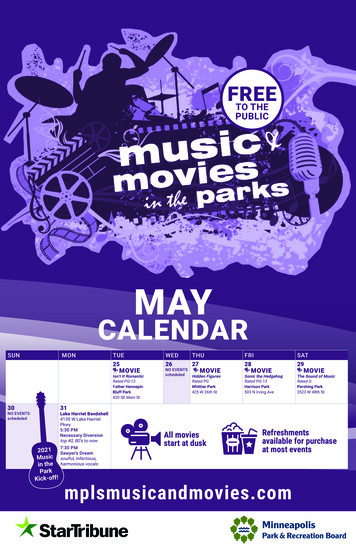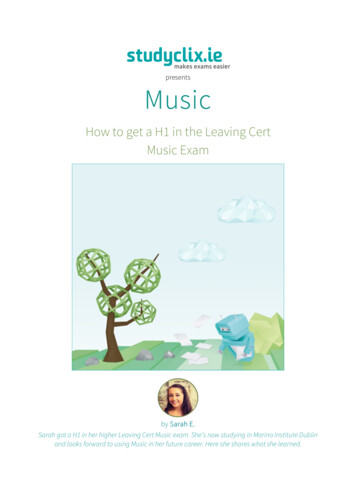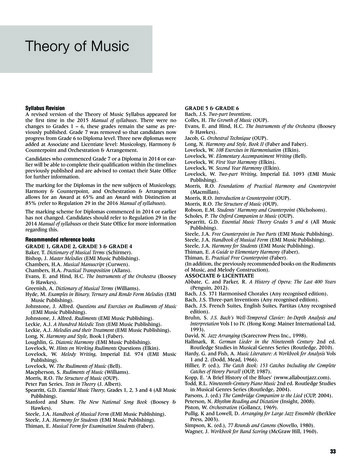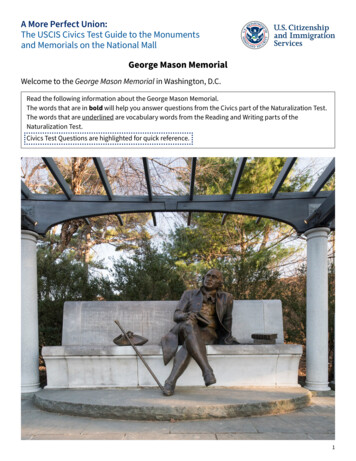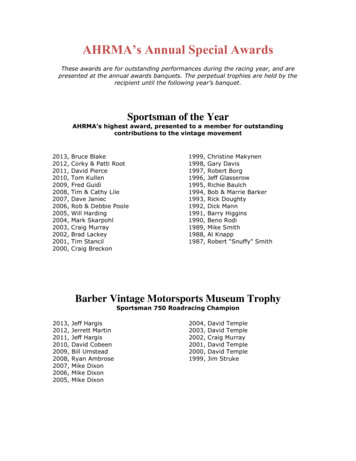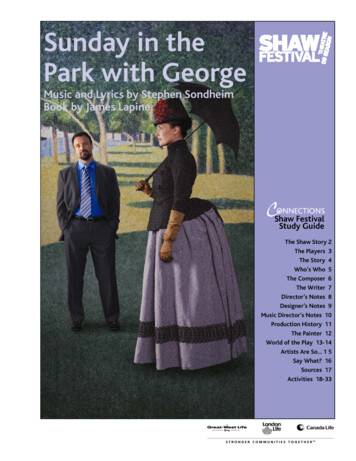
Transcription
Sunday in thePark with GeorgeMusic and Lyrics by Stephen SondheimBook by James LapineCShaw FestivalONNECTIONSStudy GuideThe Shaw Story 2The Players 3The Story 4Who’s Who 5The Composer 6The Writer 7Director’s Notes 8Designer’s Notes 9Music Director’s Notes 10Production History 11The Painter 12World of the Play 13-14Artists Are So. 1 5Say What? 16Sources 17Activities 18-33
THE SHAW STORYMANDATEThe Shaw Festival is the only theatre in the world which exclusively focuses on playsby Bernard Shaw and his contemporaries, including plays written during or about theperiod of Shaw’s lifetime (1856 – 1950).WHAT MAKESSHAW SPECIALThe Shaw Festival’s mandate also includes: Uncovered Gems – digging up undiscovered theatrical treasures, or plays whichwere considered major works when they were written but which have since beenunjustly neglected American Classics – we continue to celebrate the best of American theatre Musicals – musical treats from the period of our mandate are rediscovered and returned to the stage Canadian Work – to allow us to hear and promote our own stories, our own pointsof view about the mandate period.MEET THE COMPANY — OUR ENSEMBLE Our Actors: All Shaw performers contribute to the sense of ensemble, much like theFestival TheatreCourt House Theatreplayers in an orchestra. Often, smaller parts are played by actors who are leadingperformers in their own right, but in our “orchestra,” they support the central actionhelping to create a density of experiences that are both subtle and informative. Our Designers: Every production that graces the Shaw Festival stages is built “fromscratch,” from an original design. Professional designers lead teams who collaboratewith each production’s director to create set, costumes, and lighting designs thatcomplement the play’s text. Our Music: Music played an important role in Bernard Shaw’s life – in fact, he wrotemusic criticism for several years under the pseudonym Corno di Bassetto. Just as thereach of musical theatre is vast and manifold, so is The Shaw’s approach - presenting Brecht and Weill, Rodgers and Hart, and everything in between. Our Play Development: The Shaw’s play development programme goals include: 1) todevelop new adaptations and translations that will tell classic stories in a contemporary way; 2) to produce new plays alongside those of Shaw, Chekhov, and Coward.GEORGE BERNARD SHAWAs Artistic Director Jackie Maxwell says, “We all know the man can talk, but BernardShaw is also one of the most prescient, provocative, sparklingly articulate writers inthe English language. His words and ideas, expressed in plays that are well-known,such as this season’s The Devil’s Disciple, or in plays that are not so familiar but no lessinteresting, have extraordinary relevance today. It is a joy to draw attention to thoseideas and bring them to life on our stages.”OUR THEATRESThe Shaw Festival presents plays in three distinctive theatres. The Festival Theatrewith 869 seats is The Shaw’s flagship theatre; the historic Court House where TheShaw first began performing seats 327; and the Royal George Theatre, modeled afteran Edwardian opera house, holds 328.Royal George TheatreTHE SHAW’S COAT OF ARMSIn 1987, on the occasion of our 25th Anniversary, the Shaw Festivalbecame only the second theatre company in the world to be granted aCoat of Arms by the College of Heralds. A large painted sculpture of ourCoat of Arms adorns the lobby of the Festival Theatre.CONNECTIONS2Shaw Festival Study Guide
CStudy GuideTHE PLAYERSONNECTIONSA practical, hands-onresource for theclassroom whichcontains backgroundinformation for theplay, suggestedthemes for discussion, and Ontariocurriculum-basedactivities. Designedby educators andtheatre professionals, the activities andthemes for discussionare organized inmodules that can beused independentlyor interdependentlyaccording to the classlevel and timeavailability.Sunday in the Parkwith George isrecommended forstudents in grade 7and higher.This guide waswritten and compiledby Suzanne Merriam,Sarah Sheridan andAmanda Tripp.Additional materialswere provided by:Joanna Falck, PeterVietgen, PaulSportelli, JudithBowden, and AlisaPalmerCover: Blair Williamsand Nicola CorreiaDamudePhoto by Shin SuginoPreviews April 1Opens May 22George/GeorgeDot/MarieOld Lady/Blair DanielsNurse/ Harriet PawlingJules/Bob GreenbergYvonne/Naomi EisenBoatman/Billy WebsterCeleste #1/ElaineCeleste #2/WaitressBather/LouiseFranz/DennisFrieda/ BettyBather/Soldier/AlexMr/Charles RedmondMrsLouis/Lee RandolphBather/Woman/PhotographerBather/Man/Museum AsstHorn playerSTEVEN SUTCLIFFEJULIE MARTELLSHARRY FLETTGABRIELLE JONESJAY TURVEYPATTY JAMIESONMARK UHREROBIN EVAN WILLISSACCHA DENNISCELESTE BRILLONALIX BOYDKYLE BLAIRMELANIE PHILLIPSONKAWA ADANEIL BARCLAYMELANIE JANZENANTHONY MALARKYJACQUELINE THAIRKELLY WONGCHRISTINE PASSMORETHE ARTISTIC TEAMDirectorMusical DirectorChoreographerDesignerLighting DesignerALISA PALMERPAUL SPORTELLIBILL COLEMANJUDITH BOWDENALAN BRODIETHE STORYA compelling story about inspiration - in art and in life. Spend Sundaysin the park with the French impressionist painter Georges Seurat as hecreates his masterpiece, “A Sunday Afternoon on the Island of LaGrande Jatte”. A hundred years later, his great-grandson, another artist,learns from the ghosts of the past.CONNECTIONS3Shaw Festival Study Guide
Sunday in the Park with George“Artisn'teasy”George - Sunday inThe Storythe Park withGeorgeMore than a hundred years ago, artist Georges Seurat challenged hisaudience to experience the art of painting from a new perspective. Whenthe musical Sunday in the Park with George by Stephen Sondheim and JamesLapine opened in 1984, it too presented a challenging concept for theatreaudiences.Sunday in the Park with George is a musical, entirely fictitious, using Seurat’slife as its inspiration. The show examines the creation of a singlepainting, “A Sunday Afternoon on the Island of La Grande Jatte”. Thefirst act begins with a blank canvas, in an island park on the Seine in1884. We follow the troubled relationship between George and hismistress Dot, watching it unravel as George explores a new art form,pointillism. The crowd of bourgeois 19th century Parisians in the parkbecome the subjects for Seurat’s painting. At the end of the act we seethe finished painting.Act II is an exploration of how Seurat’s painting has impacted futuregenerations and how art, like love, can reverberate through time. Set in1984, New York, Seurat’s great-grandson is a modern day conceptualartist, facing creative bankruptcy. Although he is a consummate salesmanof his own work, the process of making art has lost its meaning for him.His faltering artistic vision andconfidence are restored after a visitto La Grande Jatte where theimpressionistic setting that inspiredhis great-grandfather’s work hasbeen replaced by cubist architecture.George, the contemporary artist, isencouraged by the spirit of his great-grandmother Dot to stop worryingabout what others think and “justkeep moving on.” By connectingSeurat’s great-grandson, George,with his past, he is able to find aattempting to finance his art, while losing himself direction for his future.as an artist.Throughout the musical Sunday in the Park with George the charactersstruggle with the nature of the creative process, the limitations placed oninterpersonal relationships by artistic commitments, and the danger ofartists responding to a fad rather than respecting their own impulses.Description from The MTI Study Guide for Sunday in the Park with George.CONNECTIONS4Shaw Festival Study Guide
OldLady,A SoldierGeorge’s & hismother companionNurse,cares forthe oldladyCelesteYvonne, Louis, aMr & Mrs, anJules’sbakerAmerican couple #1, ashopwifeMarie, Dot &girlGeorge’s babyCeleste#2,anothershop girlJules, afellowartist,marriedtoYvonneSunday in the Park with GeorgeWho’s WhoFranz,servant toJules &Yvonne,and isinterestedin NurseFrieda,Boatman,Spot, Fifi, acook forSpot’s ownera dog pugJules &Who is missingYvonne,wife tofrom the painting?Franz &George Seurat, thehas anartist.affair with“Look, I made a hat.Where thereJulesnever was a hat.”ACT 2BlairDanielsart Redmond,visitingcuratorLouise,youngdaughterof Jules&YvonneDot, George’smistress &eventual motherof his childACT 1Marie, George’s grandmother (also GeorgeSeurat & Dot’s daughter)Dennis,George’stechnicianAlex, artistBob Greenberg,museumdirectorBilly Webster,Harriet’s ge, anartist, thegreatgrandson ofGeorge SeuratCONNECTIONS5Shaw Festival Study Guide
Stephen Sondheim - Composer and LyricistStephen Joshua Sondheim - born 1930“I care a lot about art and the artist The major thing Iwanted to do in the show was to enable anyone who is not anartist to understand what hard work art is.”-Stephen SondheimThe name of composer and lyricist Stephen Sondheim has become synonymous with experimentationand excellence in the field of musical theatre. Bornin New York City, he moved to rural Pennsylvaniawith his mother when his parents separated, where their neighbours includedthe famous lyricist Oscar Hammerstein II. Sondheim began piano lessons atage seven, wrote original musicals in high school and college, and aftergraduation wrote several episodes of the television series Topper.After a couple of attempts at Broadway musicals, Sondheim learned, througha casual conversation, that a budding musical called East Side Story needed alyricist. He soon found himself working with two of the most talented artistsin music theatre, director-choreographer, Jerome Robbins, and one of theworld's most important musician/composers, Leonard Bernstein.That 1957 show was ultimately called West Side Story but before Sondheimcould capitalize on it and pursue his composing ambitions, Hammersteinurged him to write for a star. The show was Gypsy, the star was Ethel Merman.When given the chance to write his own music and lyrics in A Funny ThingHappened on the Way to the Forum, he found that although the show was a hit,his songs were not. Forum won a Tony Award,but the score wasn't even nominated.Another eight years would pass before, at theage of forty, he'd be given any recognition as acomposer for Company. Even then, he wasadvised to concentrate on writing lyricsbecause people couldn’t "hum his tunes."Sondheim & James LapineIn the years that followed, Stephen Sondheimestablished himself as Broadway's mostambitious and principled practitioner. Everyone of his shows was of serious artistic intentand uncompromising integrity. Each wasunique, attempting the dangerous or, in hiswords, the "unexpected". From childhoodinto his seventies, he has brought the musicalstage to its most mature development, withoutever losing his young sense of its exhilaration.CONNECTIONS6Shaw Festival Study Guide
James Lapine -Born 1949This Ohio native is known for both his successes as awriter and as a director. He began his career as aphotographer and graphic designer and taught graphicdesign at the Yale School of Drama. While there, headapted and staged Gertrude Stein’s play Photograph,performed Off-Broadway in 1977.He began working with Stephen Sondheim in 1983with their first collaboration on Sunday in the Park withGeorge. The duo turned then from inspiration in art toinspiration in fairy tales to write Into the Woods (1987),which was directed by Lapine. This production earned Lapine and Sondheimthe Best Book and Best Score Tony Awards.James Lapine - BookHe collaborated with William Finn anddirected Falsettos, which won the TonyAward for Best Book in 1992. The second part of Falsettos, Falsettoland won theOuter Critics Circle Award for Best Musical.What Kind of Book?!Stephen Sondheim & James LapineSome Important Definitions of Musical Theatre Terminology:Book: The book refers to the dialogue (the unsung part) of the musical.Composer: The person who writes the music is called the composer.Libretto: The combination of dialogue & lyrics together, such as in opera.Lyrics: A set of words that accompany a piece of music.Lyricist: A person who writes the lyrics for songs.Score: The written form of a musical composition, including music for all ofthe instruments and lyrics for the singers.CONNECTIONS7Shaw Festival Study Guide
Alisa Palmer - Director for“Sunday in the Park with GeorgeKnowingourselves isperhaps thehardestwork of art.”Director’s NotesAlisa Palmer - DirectorSunday in the Park withGeorge tells the story of twoGeorges, two artists, onehundred years apart. OneGeorge is based on thefamous 19th-centuryimpressionist painter GeorgesSeurat. The other George is acompletely fictional character,the great-grandson of Seurat,a 20th-century installationartist and inventor. It'sabout the amazing things thatcan happen when we pausein our work - take a breath, a sideways glance - and life suddenly appears as a blankcanvas, teeming with possibilities. It's also about the hard emotional work that goesinto making ourselves available to these moments.Sunday in The Park with George is a study in contrasts. Like the colours in Seurat'spainting, the juxtapositions of different elements, characters and worlds creates a fullerand more vibrant picture of the whole. For this production, designer Judith Bowdenand I were inspired by Seurat's working method - he was thorough and meticulous,experimenting with form and composition in black and white before creating hismagnificent colour paintings. In the contemporary second act we looked to thepioneering work of Bill Viola, a prolific video artist whose exquisite explorations oflight and shadow, stillness and movement have often been imitated by less soulfulartists. Both artists in Sondheim's musical work incredibly hard - one at creating hiswork, the other at creating the conditions for his work. And both are missingsomething. Here the musical moves beyond being a specific story of artists to a moreuniversal story; what does it mean to live well? How can we live and love fully? BothGeorges work extremely hard and for both, work is a refuge; from loneliness, from thesense that something is missing. They use work to fill up the empty spaces and replaceintimacy with intensity.This musical was inspired by a painting that is a reverie of a day off. The people on LaGrande Jatte are not working, and are vividly alive in their stillness. Perhaps Seuratlonged for this ordered calm. Perhaps he intuited that life can be richer when we dareto pause. When George in the second act comes to the La Grande Jatte - to this parkon a Sunday one hundred years later - he is at the peak of his professional career but atthe nadir of his existence. He's looking for people and comfort but is met withemptiness. It is in these moments of despair that we crack open and becomeavailable to the extraordinary. George experiences the impossible: he is visited byghosts of the past, spirits of creative impulse, by his ancestors and by timeless muses.When we stop working, when we lay down our familiar tools of survival the impossiblecan happen. In this moment of creative inspiration we can meet our greatest source ofpower: ourselves. Knowing ourselves is perhaps the hardest work of art.CONNECTIONS8Shaw Festival Study Guide
Judith Bowden - Set Designer“I am nothidingbehind mycanvas. Iam living init.”George-Sunday in theDesigner’s NotesPark with GeorgeSunday in the Parkwith GeorgeIn the musical Sunday in the Park with George the terms Design, Composition, Tension,Balance, Light, and Harmony are repeated throughout the production. Judith Bowdendescribes what these terms mean to her as a set and costume designer.DESIGN – As a set and costume designer this term is really self-explanatory. In designing a set I try to create a visual world that supports, enhances, and reinforces the storyor journey of the play or musical. I believe the set and costumes are an extension of theheart of the performance. In the set and costume designs for Sunday in the Park withGeorge, I have tried to understand, to use, and to support all the elements that were important to Seurat, including design.COMPOSITION – I am constantly aware of creating stage pictures that are always inmotion – not a static picture. When I design, the composition is important. Being ableto guide the focus – for example, where is the strongest position to put a door, a window, and how does that affect how a scene will be played out? How close or far apartwill the actors be based on the placement of furniture? Costumes also are an importantaspect of composition, with their ability to focus the attention of the audience.TENSION – Within a design composition tension relates to focus. In Sunday in the Parkwith George the idea of tension, or excitement, comes through Seurat’s interest in opposite colours. It is the huge opposing differences that create tension, or friction, resultingin great liveliness. Tension also comes into play with costume design as wardrobe canreflect the inner tensions of characters who feel one way inwardly yet display contrastingoutward appearances.BALANCE – Everyone has an eye for balance when it’s wrong. We won’t necessarilyknow exactly what is wrong, but it has to do with balance. We relate everything in theworld in terms of our own human proportions, so balance comes through perspective.When designing a set I make choices as to whether the balance will be symmetrical orasymmetrical, or whether elements repeat, in order to achieve some sort of balance thatwill provide harmony to the overall picture.LIGHT – In his painting, Seurat played with light and colour. His theory - that we cannot see an object without light, led him to experiment how colour was determined bythe way light hit it. In the theatre, when I design a set, I place things in positions knowing that light will hit them in different ways, affecting the mood, the balance, the tension. I also choose certain materials for the set and for costumes, as well as paint, because of the way light will hit, or reflect, or shine through the various materials.HARMONY – My goal is to create a set design that is part of the whole production, sothat the set and costumes are not a separate entity but contribute to a harmoniouswhole. I believe when harmony is working in theatre it is very expansive, the combiningof all the events lifts the audience to another level, experiencing a largesse outside of thenorm. In this musical it is interesting that musically, harmonies come in when Seuratfinishes his painting, when colour is introduced.CONNECTIONS9Shaw Festival Study Guide
Paul Sportelli - Music Director“This ismyfavouritemusical.Sunday in the Parkwith GeorgeIn the musical Sunday in the Park with George the terms Design, Composition, Tension, Balance, Light, and Harmony are repeated throughout the production. Paul Sportelli, Shaw’sMusic Director describes what these terms mean to him as a composer and as a music director.”Music Director’s NotesPaul Sportelli Music DirectorDESIGN – Design first speaks to me as a composer. If the piece of music you are composing is structured or designed properly, you will be able to convey the emotion of thepiece. The design is the architecture of the piece. As a Music Director, I must discernwhat Sondheim’s design is and bring his work to life based on his design.COMPOSITION – We all think of composition as a song or a symphony. But compositionis about what something is composed of – the elements that make up the whole. So, whatyou choose to use in your composition is as important as the composition. The way youcompose your elements results in your composition being denser or sparser, wider or not,dissonant or consonant. As a Musical Director, my job is to again discern the elements ofthe composition in a very practical way so I can break it down for the actors so they canunderstand what they are hearing. In effect, they become part of the composition.TENSION – This is a great one! Without tension, relaxation or release would not be asmeaningful. It is the interplay between tension and release that keeps us interested in music. All composers are playing with tension and release. The job of the Music Director isto determine when tensions and releases occur and how that informs the actors, how theawareness of that helps them do their job.BALANCE – This is tricky to describe because it is ephemeral. Balance has to do with howall the parts relate to the whole and the relationship to the whole that creates either balanceor a sense of imbalance. A composer is always playing with wanting the audience to knowwhere they are, versus not knowing – where the listener moves from a feeling of being lostto a feeling of coming home and the movement back and forth between the two polesdepends on the individual parts and how they relate to the whole.LIGHT – Smart composers can write music that sounds luminescent and Sondheim doesthat in spades in this piece – Sondheim found a way to capture Seurat’s concerns with colour and light and to suggest it in a musical equivalent to pointillism. The fun part of myrole as a Musical Director, is the art of interpretation – to figure out what the composer istrying to do, what the composer is trying to say, to find the meaning. With this show, allthe elements, tension, light, harmony inform us what the characters are going throughpsychologically at any moment.HARMONY – It is notable that this term is last in the list because really it is the ultimategoal. In order to achieve harmony, you need two or more things relating to each other.However, all these qualities, design, light, tension, act in relation to each other to lead tothe creation of harmony. The goal is for the audience to experience a form of transcendental release. Sunday in the Park with George is my favourite musical because I feel it is important to be transformed by an arts experience, and, in this show all the elements cometogether to a final chord of coming home . of harmony.CONNECTIONS 10Shaw Festival Study Guide
Sunday in the Park with GeorgeProduction Historybegan it’s life during workshopproductions in 1983. The showopened on May 2, 1984 at the BoothTheatre in New York, starring MandyPatinkin and Bernadette Peters. It wasdirected by James Lapine and ran for604 performances. The show went onto win the 1985 Pulitzer Prize forDrama, and two 1984 Tony Awards:Tony Straiges for Best Scenic Designand Richard Nelson for Best LightingDesign.The original cast gave a tenthanniversary concert performance (one Bernadette Peters in the original Broadnight only) at the St James Theatre onway production in 1984May 15, 1994.The show has also seen time in London,with a 1990 UK premiere production atLondon’s National Theatre, directed byStephen Pimlott. A more recentproduction began at the MenierChocolate Factory from November2005 to February 2006 then transferredto Wyndham’s Theatre. Directed bySam Buntrock, the production used21st century technology to create theworld and work of Georges Seurat. Atthe 2007 Laurence Olivier Awards inJenna Russell & Daniel EvansLondon, the production won five awardsfor Outstanding Musical Production, Best Lighting Design, Best Set Design,Best Actress in a Musical for Jenna Russell and Best Actor in a Musical forDaniel Evans.New York’s RoundaboutTheatre Company presentedthe Menier ChocolateFactory production atStudio 54 in 2008.This is the Shaw Festival’s firstproduction of Sunday in theBroadway Production in 2008 at Studio 54Park, but Sondheim is nostranger to the Festival. The first Sondheim here was Merrily We Roll Along in 2002,directed by Jackie Maxwell, and the 2008 programme included both A Little NightMusic (directed by Morris Panych) and Follies: In Concert (directed by Valerie Moore).Gypsy was produced by the Festival in 2005 and was directed by Jackie Maxwell.CONNECTIONS 11Shaw Festival Study Guide
Georges Pierre Seurat - French, 1859 - 1891 The Painter — Georges Seurat began painting as a teenager in his middle-class Parisianhomein 1880 he was attracted to the impressionists’ techniqueand began his study of colour theory and the science ofopticswas the founder of neo-impressionism, which appliedGeorges Seuratstrokes of pure colour to the canvas along more scientificprinciplesthe technique became known as pointillism or divisionism in which tiny dotsof pure colour are applied to the canvas according to the theories of opticalcolour mixing. When viewed from a distance, the dots blend into varioushues and tones while retaining the luminosity of pure pigmentSeurat’s paintings are also characterized by his use of simplified forms, andthe overall balance and sense of control in his compositions.The Bathing PlaceHis first major painting “The Bathing Place”,1883, depicted an impressionistic subject, agroup of people relaxing during an afternoonexcursion on the banks of the Seine. Thepainting has a shimmering quality and asuggestion of cut-out flatness and frozenstatic poses. From then on, Seuratconcentrated on creating very large paintingscapturing the bourgeois lifestyle in Paris.When his painting “On a Sunday Afternoon on the Island of La Grande Jatte”was shown at an Impressionist Exhibition, fellow artists Monet, Renoir, andSisley withdrew their submissions. The painting was placed in a small room, toodark for it to be seen. While the painting was initially ridiculed, the technique ofpointillism was adopted by the neo-impressionists, and eventually used widely inearly 20th century art.Seurat refined the technique and in his later work he used less naturalistic shapesand colours and introduced a theory of aesthetic harmony based on line as well ascolour. He created six more major paintings before his death, but never sold apainting in his lifetime.Seurat spent two years on this painting, “La Grande Jatte,”visiting the park on weekdays, when it was empty, and makingsketch after sketch - getting the grass right, the trees right, theriver right. Seurat’s friends, who were slightly in awe of him,were distressed to see a Frenchman working through thelunchtime break, and even (quelle horreur!) sustaining himselfwith a chocolate bar. The painting gives the impression ofsilence, of control, of nothing disordered - it is this thatChild in White (studymakes “La Grande Jatte” so moving. Seurat was 25 when he for La Grande Jatte)painted “La Grande Jatte”. He died 7 years later.CONNECTIONS 12Shaw Festival Study Guide
Impressionismdeveloped primarily in France during the last part of the 1800’s. The majorcharacteristic of impressionism is the focus on the importance of colour, light,and movement when painting outdoor subjects.Impressionism is also used to describe apainting that involves an interest insubjects who where informal and pleasant.The name “Impressionism” came fromthe title of a painting by Claude Monet,called Impression: Sunrise. Monet namedthe painting this because an impression ofthe subject was conveyed in the paintingwithout specific details.The key figures of the Impressionistmovement were Claude Monet, AugusteRenoir, Camille Pissaro, Alfred Sisley,Edgar Degas, Berthe Morisot & EdouardManet.Claude Monet’s Impression: SunriseThe World of the PlayPointillism.is the technique used by Georges Seurat to portraythe play of light using tiny brushstrokes of purecolour side by side. This new style developed bySeurat was based on scientific findings on colour.Close up, these tiny brushstrokes of colour areobvious. However, at a distance the eye fuses thecolours together to create a wide range of secondaryand intermediate colours. By not mixing the colourstogether on the pallet, the colours appear brighterand lighter on the canvas.“So, your eye is perceiving both red and blue and violet. Onlyeleven colours, no black - divided, not mixed on the palette,mixed by the eye. Can’t you see the shimmering?”Above: Detail ofGeorges Seurat’sSunday Afternoonon the Island of LaGrande JatteRight: GeorgesSeurat’s SundayAfternoon on theIsland of LaGrande JatteCONNECTIONS 13Shaw Festival Study Guide
Dramatic DevicesMetaphor is a figure of speech in which a comparison is made between twoseemingly unrelated objects without using "like" or "as."Example: Life is a yo-yo. It's a series of ups and downs.Here, "life" is the subject. "Yo-yo" is the symbol that represents the subject.In Sunday in the Park with George, many of the characters are one-dimensional,some even being cut-outs of human beings. This metaphor explains that toGeorge, (who has trouble connecting with people) some of the characters inhis paintings are only one-dimensional.Dramatic DevicesPersonification is giving human qualities to animals or objects.Examples: a smiling moon, a jovial sunThe dogs Spot and Fifi are given voices and desires in Sunday in the Park withGeorge, thus giving them human qualities. The painting coming to life is alsoan excellent example of personification, as an inanimate object such as apainting is given human thoughts, emotions, and actions.Cross-Casting: Sometimes in order to create a connection between scenes,acts, or characters, playwrights and directors will cross-cast the same actors toplay different, but sometimes connecting roles. There are examples of this inSunday in the Park with George. Here, the cross-casting is used to connect Act 1& 2, as well as connect the characters who are 100 years apart. Keep in mindMarie’s song “Mama” where she is singing about her mother, Dot, who isplayed by the same actor.Dramatic Irony is when the audience knows more about a situation than thecharacter knows. Think about those times when you want to yell at the stageor screen to tell the character to do, or not to do something! We know as anaudience that George is inventing a new style of art, while his contemporariesare criticizing his work. We also know that by ignoring Dot, George is losingthe love of his life.COULD YOU DOTHIS?As part of an effort to promote a newe
Forum won a Tony Award, but the score wasn't even nominated. Another eight years would pass before, at the age of forty, he'd be given any recognition as a composer for Company. Even then, he was advised to concentrate on writing lyrics because people couldn't "hum his tunes." In the years that followed, Stephen Sondheim


